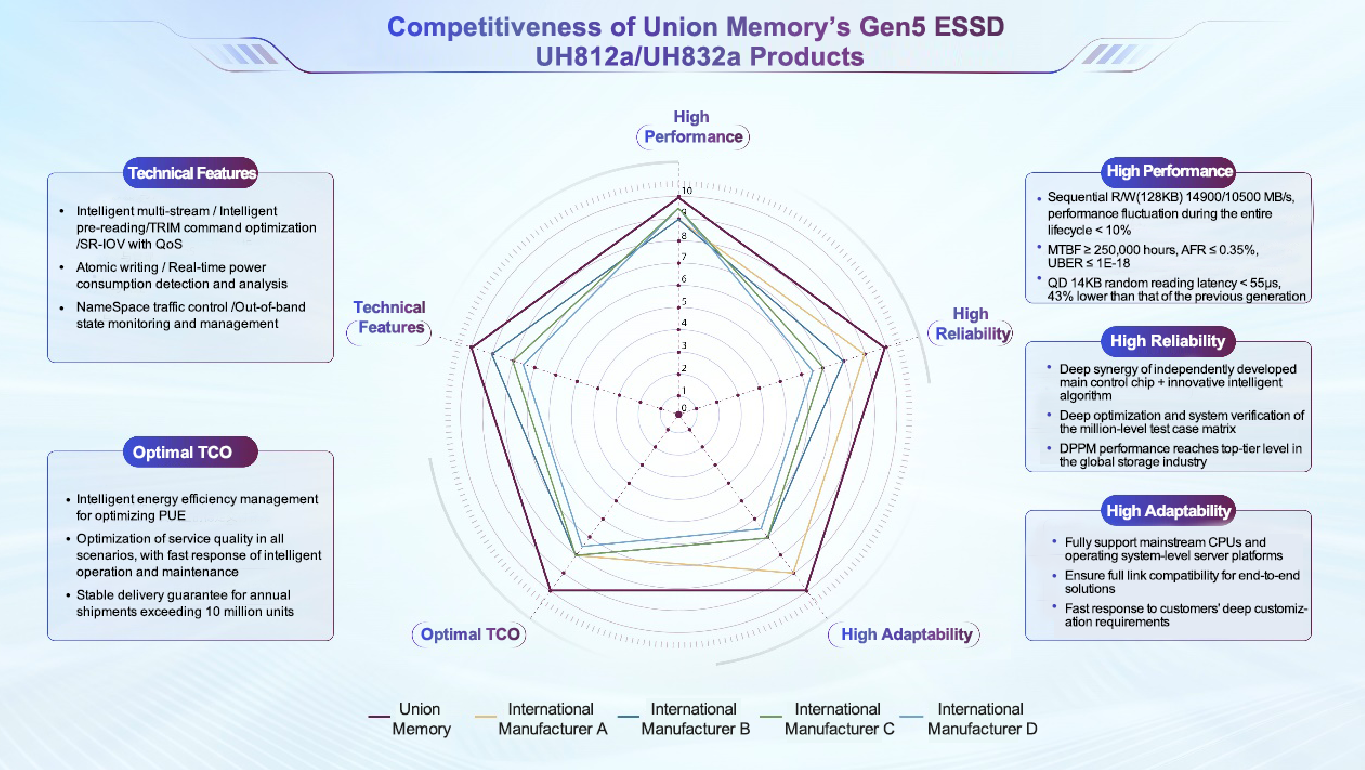
Date: Jul. 28, 2025 Read: 656
Share:




Recently, Union Memory's new generation PCIe 5.0 enterprise SSD UH812a successfully passed the performance benchmark test of the Intel's Data Center and AI Group (DCAI) at the Intel DCAI China Key Component Verification Program, becoming the first domestic storage manufacturer being successfully verified. The test results showed that UH812a significantly outperformed mainstream competitors of the same generation in key performance indicators. Its outstanding performance and stability fully unleashed the potential of the PCIe Gen5 high-speed bus and platform memory bandwidth, and meanwhile, it strongly demonstrated the successful cooperation between Union Memory and Intel in the field of data center storage.
As an important part of the Intel DCAI China Key Component Verification Program, Intel's Benchmark aims to quantitatively evaluate the performance of computer hardware or software under specific workloads through standardized and repeatable testing methods and indicator systems. Through full-stack verification covering typical user scenarios, spanning the entire technical chain from physical layer signal integrity to application layer algorithms, it fully demonstrates Union Memory's industry-leading technical strength.
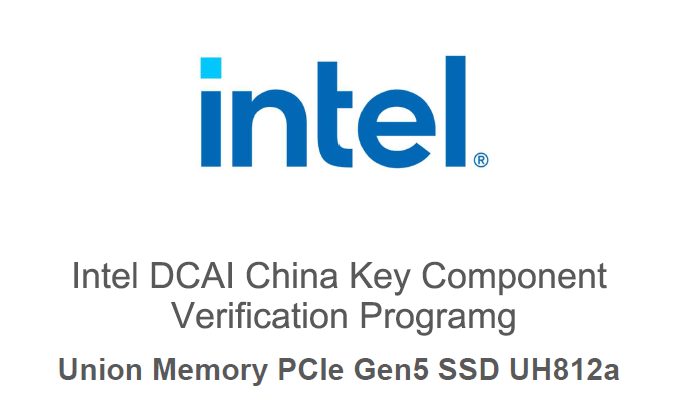
Intel DCAI China Key Component Verification Program
Intel DCAI China Key Component Verification Program aims to leverage the collaborative efforts between Intel and its partners to conduct comprehensive validation of key components (such as SSDs and memories) within servers on the Intel Xeon® platforms. This initiative evaluates design innovations as well as performance, compatibility, reliability, and functionality, facilitating the introduction of partner's latest products to end users, and aiming to jointly build an efficient, high-quality, and healthy x86 server ecosystem supply chain.
Intel's Benchmark Test: UH812a Outperforms Competitors of the Same Generation
NVMe SSD performance benchmark test aims to comprehensively evaluate the key indicators of SSDs, including reading/writing speeds, latency, and IOPS (input/output operations per second), and is an important metric for measuring the capacity of storage devices and guiding purchasing and application decisions. Through the benchmark test, the performance of NVMe SSDs under different workloads, such as sequential reading/writing and random access capabilities, can be quantified to determine if they are suitable for specific scenarios, such as high-performance computing, databases, or data center storage. In addition, the test can reveal the stability and durability of SSDs under long-term operation or high-pressure environment, helping users conduct comparative analysis across brands or models to support informed decision-making for consumers and enterprises.
The following are the relevant configuration details of Union Memory UH812a performance test conducted on the Intel Birch Stream platform.
l System Configurations

Source: Intel Benchmark Performance Test Report
l Test Indicators
It mainly includes the following three key indicators:
Throughput (Reflects sequential reading/writing performance)
IOPS (Input & Output Operations Per Second, Reflects random reading/writing performance)
Latency (Reflects command response time)
l Parameter Configurations
Sequential reading/writing: Block Size = 128KB, Queue Depth = 128
Random reading/writing: Block Size = 4KB, Queue Depth = 64 or 128
Mixed reading/writing: Block Size = 4KB, Queue Depth = 128, 70% reading operations, 30% writing operations
Latency test: Jobs = 1, Queue Depth = 1
The test results show that UH812a has outstanding performance, not only meeting but exceeding the design targets. It significantly outperforms the mainstream competitors of the same generation in key performance indicators, fully releasing the performance potential of the PCIe Gen5 high-speed bus and platform memory bandwidth.
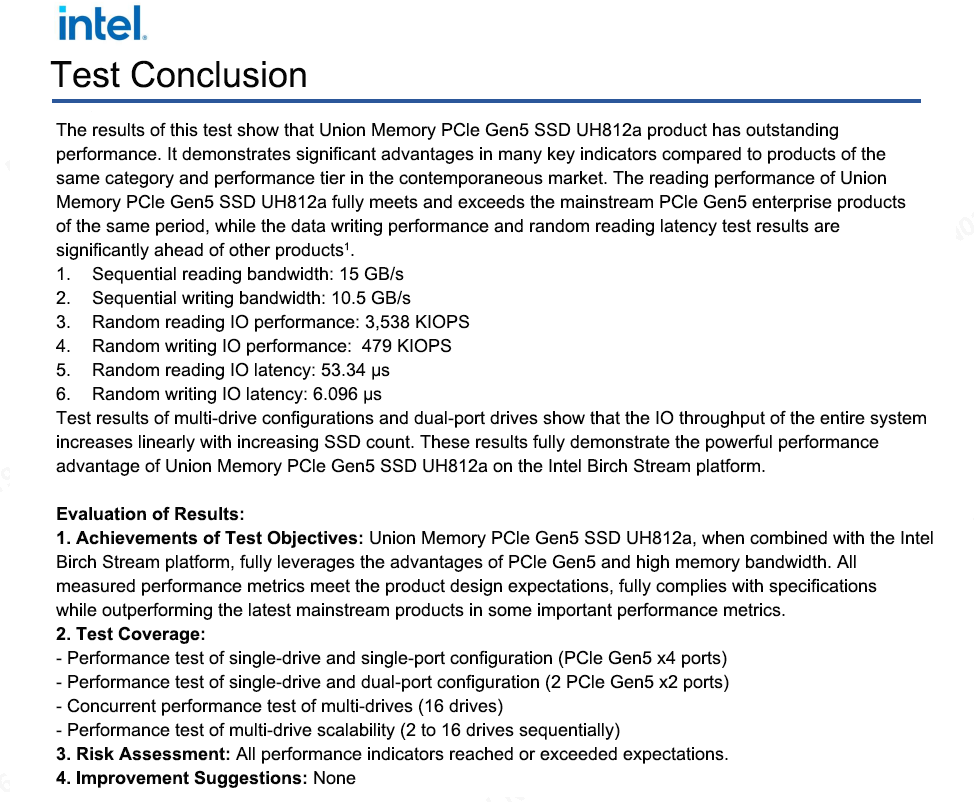
Source: Intel Benchmark Performance Test Report
Across diverse deployment scenarios, UH812a consistently delivers excellent performance
This Benchmark test covers various typical deployment scenarios, including single-drive single-port (PCIe Gen5 ×4), dual-port (2× PCIe Gen5 ×2), multi-drive concurrent access (up to 16 drives) and linear multi-drive scaling scenarios. In terms of core performance, UH812a demonstrates excellent performance consistency and leading advantages in sequential reading/ writing bandwidth, random reading/writing IOPS, 1QD command latency, and mixed workloads (70% reading operations/30% writing operations) items.
l Outstanding Reading/Writing Performance: Union Memory UH812a, based on the PCIe Gen5 interface standard, has a sequential reading speed of up to 15,000 MB/s and a sequential writing speed of 10,500 MB/s, which are at the industry-leading level. It also performs well in random reading/writing. The 4KB random reading IOPS is as high as 3538K, and the random writing IOPS is 479K. This performance advantage can easily handle the PB-level data loading requirements in large model training, and provides extremely low latency response for real-time operation scenarios such as financial transactions, e-commerce platforms, and social interactions, ensuring fast data reading/writing and smooth operation experience.
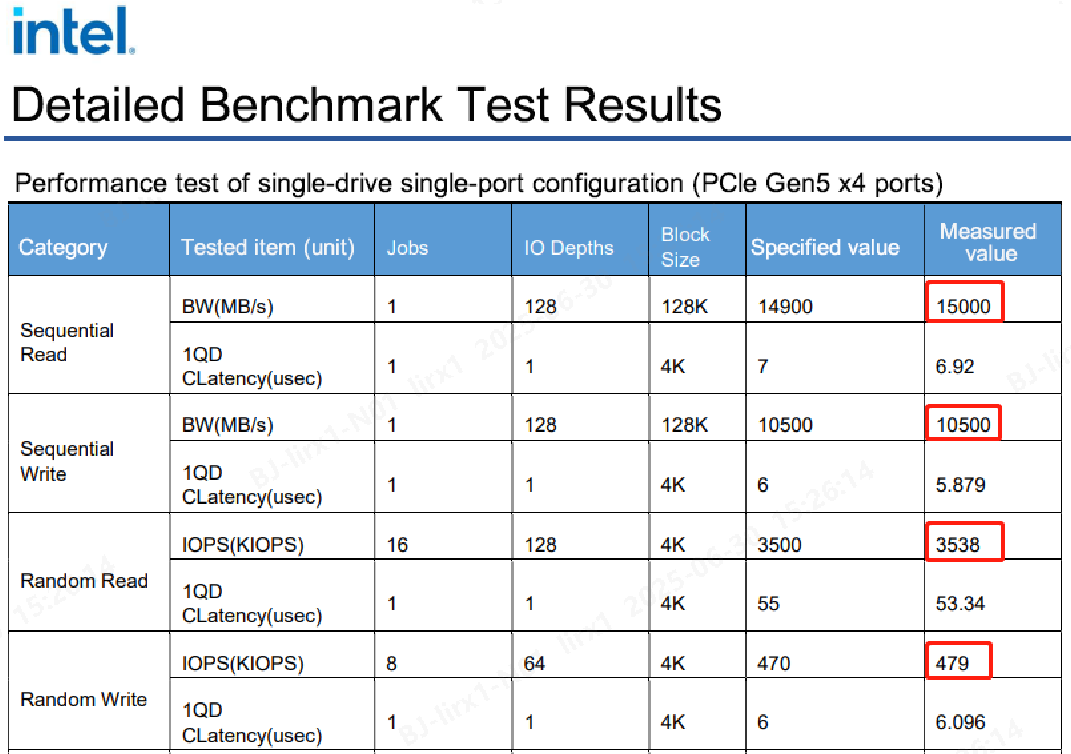
Source: Intel Benchmark Performance Test Report
l Stable Low Latency: Union Memory UH812a is outstanding in ultra-low latency feature. The4K random reading QD1 latency is less than 55μs. Compared with that of the previous generation (PCIe 4.0 SSD), it is improved by 43%, and it is 25% better than that of international competitors. The 4K random writing performance ranks TOP1 among competitors. Whether running complex simulation programs or processing massive data sets, it can achieve microsecond-level response, laying a solid foundation for high-performance computing and data-intensive applications.
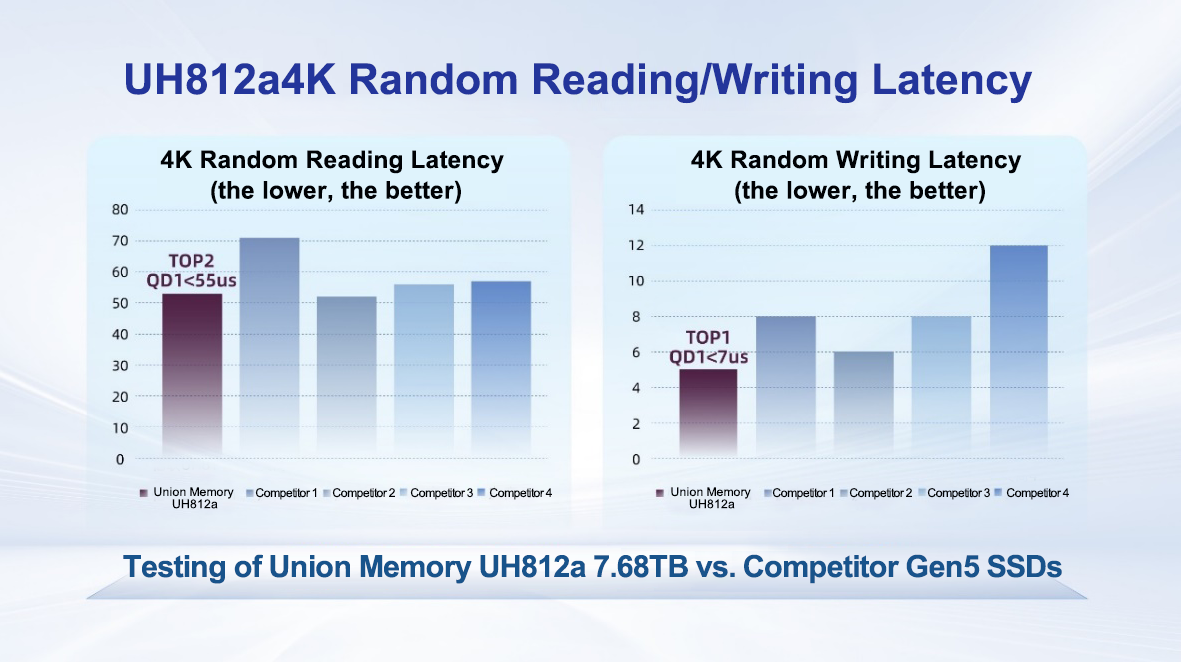
Source: Measured Data of Union Memory UH812a
l Excellent Scalability and Compatibility: Union Memory UH812a not only leads in single-drive performance, but also demonstrates significant advantages in multi-drive extension scenarios (1 to 16 drives): The multi-drive configuration demonstrates linear performance scaling, with aggregate bandwidth exceeding 230 GB/s; As the concurrent load increases, the performance remains stable, with IOPS exceeding 50 million and without bottlenecks, and the performance fluctuation rate between drives is lower than 5%. This fully validates its outstanding concurrent processing capability and powerful collaborative scalability.
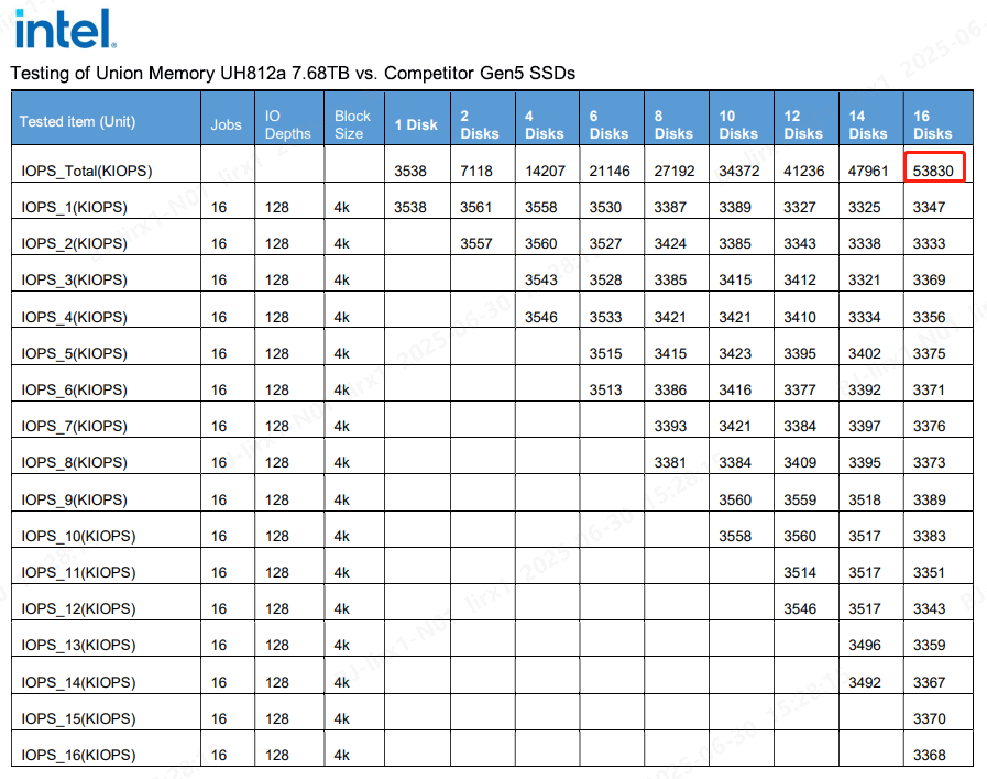
Source: Intel Benchmark Performance Test Report
To meet the surging needs for data storage, Union Memory UH812a successfully passed the strict BKC verification and PCIe link stability test by Intel, achieving zero-defect compliance. The Benchmark performance test results are even beyond expectations. This marks another significant breakthrough in the cooperation after both sides completed the joint verification of BKC and PCIe link stability. This achievement will accelerate the upgrade and iteration of storage solutions, providing industrial customers with higher performance, stronger stability and more reliable products. In the future, Union Memory will continue to drive innovation through technology, gather advantages through ecological collaboration, and promote continuous performance breakthroughs, empowering the high-quality development of data center industries in China and globally.
